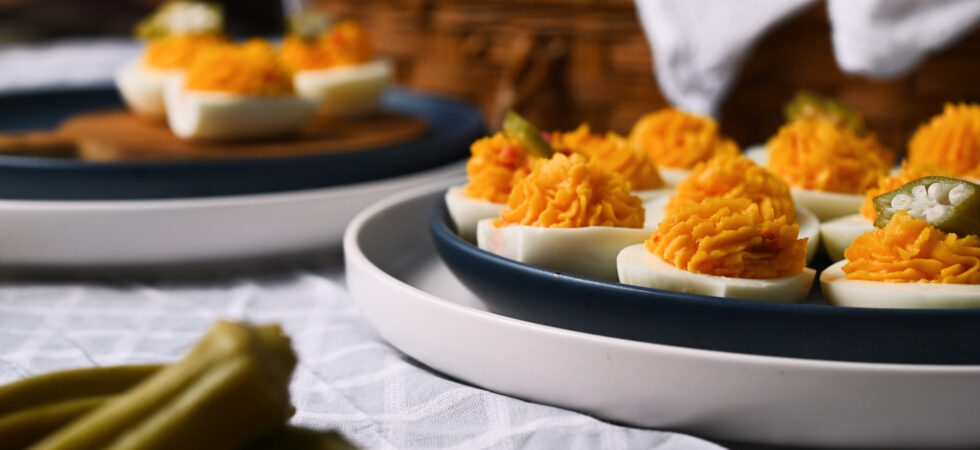Pimento Cheese Deviled Eggs

I’m back with another egg-citing twist on a classic dish, pimento cheese deviled eggs! The inspiration came from a local wine bar my husband and I love. The bar has a cheese board we order all of the time, with homemade pimento cheese and pickled okra. I just can’t get over the flavor combo. So, I decided to have some fun and drop a few egg-ceptional puns where I could. Sorry, I’m definitely not sorry!

Get the Recipe: Pimento Cheese Deviled Eggs
Ingredients
- Enough water for boiling the eggs
- 12 eggs
- 2-3 cups of ice
- 2 tablespoons, 1oz, cream cheese
- 3 tablespoons mayonnaise
- ¼ teaspoon garlic powder
- 1 teaspoon dill pickle juice
- ½ teaspoon distilled vinegar
- ½ teaspoon onion, finely grated
- 2 oz jarred pimento peppers, finely chopped
- 1⅓ cup, 4oz, extra sharp cheddar cheese, grated
Equipment
- 1 medium mixing bowl
- 1 kitchen scale (optional)
- Measuring spoons
- 1 fine mesh grater
- measuring Cups
- 1 medium grater
- 1 chef knife
- 1 cutting board
- 1 spatula or fork
- 1 stock or soup pot
- 1 slotted spoon or spider
- 1 large mixing bowl
- 1 pastry bag with large piping tip (optional)
Instructions
- First, fill a pot with enough water to cover 12 eggs with 1in (2.5cm) of clearance. Place the pot on your stovetop and bring the water to a gentle boil. Once bubbling, carefully add in the eggs, so they don't crack. Cook the eggs for 10 minutes. I suggest setting a timer to make sure you don’t overcook the eggs.
- While they boil, get an ice bath ready. Fill a large bowl about halfway with water and add in 2-3 cups (.5L container) of ice. You can also take out your tools and ingredients for the pimento cheese-egg yolk filling. 9 minutes isn’t a long time, so I wouldn’t begin measuring anything out.
- When your timer goes off, turn off the burner and use a slotted spoon or spider to immediately transfer the eggs from the pot to the ice bath. Shock the eggs in the ice water for about 15 minutes.
- While they are cooling in the ice bath, start adding the pimento cheese ingredients to a medium mixing bowl. First measure out and add the cream cheese, mayo, garlic powder, dill pickle juice, and vinegar. Then, grate the onion with a microplane or fine grater and add it to the bowl. Before mixing, chop the pimentos on a cutting board. Even the pre-diced ones are a little too big for piping the final filling back into the eggs. Add them to the bowl and mix. I prefer to first mix everything but the cheese really well for a better flavor consistency.
- Once mixed, grate the extra sharp cheddar cheese and add that to the bowl, doing a quick second mix. The cheese will break up into smaller pieces, but you don’t need to have the perfect consistency yet, as the egg yolks are still left to add.
- Time to peel and half the eggs. Take an egg and tap it against the counter on the top and bottom until it cracks. Rotate to the egg’s side and continue tapping all around the middle of the egg. (Do NOT roll your eggs on the counter) Start peeling where the egg’s shell has come away from the egg the most. You should feel a pocket of air.
- Peel until all of the eggs are free of their shells. Then, cut each egg in half, longways. Use a small spoon to pop the egg yolk away from the egg white and into the bowl with the filling. Rinse the egg whites of any residual yolk and set them aside. Mix the egg yolks into the pimento filling. It should become relatively smooth with only the pieces of pimento and some cheese pieces still intact.
- At this point you can spoon the pimento cheese-yolk filling into the egg whites or add it to a piping bag and fill them that way. Then, it’s time… time to egg-splore a word of deliciousness. (still not sorry!)
Notes
- This recipe can be easily halved in 1 of 2 ways:
- 1.) Half the above ingredients and use 6 eggs
- 2.) Make pimento cheese + 6 pimento cheese deviled eggs. Follow the recipe as written but use only 1 tbsp of mayo and no vinegar to make pimento cheese. Then, half of the pimento cheese and to one half, add in 6 egg yolks, 1 tbsp (15ml) mayo, and vinegar to taste. Best of both worlds! YUM!
- If you don’t keep pickles in your house or want to buy pickles for such a small amount of juice. Substitute it for distilled vinegar.
- The completed pimento cheese deviled eggs will last up to 4 days in the fridge. Make sure to cover them well, so they don’t dry out.
- You can make the pimento cheese mix and hard-boiled eggs up to a week in advance. Just make sure to leave the eggs unpeeled. And take the pimento filling out of the refrigerator, to soften, 30 minutes before mixing in the yolks and assembling everything.
- Feel free to add more mayo for an even creamier texture and extra vinegar or dill pickle juice to taste.
- Also consider adding in some old bay, cayenne, or a hot sauce of your choice to the filling. My favorite toppings include anything pickled: okra, cucumbers, jalapeños, radishes, etc and/or largish pieces of ritz cracker.
Nutrition

Frequently Asked Questions
Pimentos or cherry peppers are a small, heart-shaped, sweet, and mild pepper similar in flavor to a bell pepper. They are among the mildest chili peppers, with a Scoville heat rating between 100 and 500. In the U.S.A. it is most common to see pimentos, pickled and stuffed into cocktail olives or in it’s dehydrated and ground up form, paprika.
You can always cut off the top of a plastic bag in an arch along the seal and snip the corner off. Viola! Press your makeshift bag into a plastic cup and fold the edges over the cup lip. Then, spoon the filling for the pimento cheese deviled eggs into it. Twist the open back end and have at it!
There are two great ways to cook a hard-boiled egg, boiling and steaming. To boil follow the instructions listed in the recipe above.
To steam, add about 1in (2.5cm) of water to the bottom of a pot and bring it to a boil. Place your eggs into a metal steamer basket, metal steaming rack, or collapsible veggie steamer and lower it into the pot once the water is boiling. Cover the pot and cook for the same cook time you would use when boiling the eggs.
I prefer a 9–10-minute cook time for my hard-boiled eggs. You end up with a fully solid, slightly jammy, but fully cooked yolk. The chalkiness of a fully set yolk is off putting to me, but if you feel more comfortable with that level of cooked, I totally understand. To achieve that amount of hard-boiled egg, you are going to want to cook your eggs between 12-13 minutes.
Of Note: If you do cook your eggs longer, you will also need more mayonnaise to create a creamy texture for the pimento cheese deviled eggs. Add it to your tastes. 🙂
There is no 100% easy peeling unfortunately. But, these used together will serve you better than anything else.
Use older eggs: As an egg ages, it undergoes a natural process of moisture loss and gas exchange, which results in the formation of a larger air cell at the bottom of the egg. This air sack creates a small space between the eggshell and the egg white and makes it easier to separate the membrane from the shell when peeling. I’m not talking past expiration. Think like a week or so from purchase.
Boil the water before adding the eggs: Add your eggs to boiling water always. The heat of the water immediately coagulates the proteins in the egg white, bundling them to each other faster than they can fuse with the membrane.
Shock the eggs in an ice bath: An ice bath immediately stops the eggs from cooking and causes the egg to contract away from the membrane. I don’t recommend leaving the egg in the ice bath long enough for temperatures to normalize. At some point the egg gets warmer and will expand a bit.
Not important for anything other than clearing pieces of cracked shell away as you peel, but still helpful. If you want to make the process less messy and have less shell around to slice into your cooked eggs, run some cool water from the faucet over the eggs while you peel.
So, here’s the dilemma. The older the eggs, the easier they peel. But, the older the eggs, the bigger air pocket they have at their bottom causing misshapen results.
If you want a higher chance of escaping the flat bottom that occurs more frequently the older the eggs get, try this. Take a push pin and poke a small hole in the large end of the egg before boiling it. The hole lets air escape from the air pocket at the large end of the egg, allowing for the egg to fill that space spherically as it cooks.
One caveat. If you manage to pierce the membrane by accident, you may end up with some leakage, cracking, or pitting in your eggs. Is it worth having beautifully shaped eggs? Up to you!
Always add your eggs to boiling water. The heat of the water immediately coagulates the proteins in the egg white creating a greater chance of easy peeling. If you really want to, you can lower the boil to a simmer after about 30 seconds to keep the eggs from cracking or knocking against each other.
Even though it seems like it would, the answer is not really. Water temperature itself doesn’t significantly affect the cook time of the eggs. Once water reaches its boiling point (212°F or 100°C) it will not get hotter, it just evaporates faster. Because the egg is contained in a shell the bubbles and rolling water don’t create any convection or direct heat in, say, something like boiling pasta or meat. It’s all simply ambient heat transfer.
Not that I can tell. Some people swear by one or the other, but if making the water acidic or making the water alkaline are both somehow mutually exclusive hacks, the chemistry there doesn’t math right.
That being said, the more acidic (fresh) an egg is the harder it is to peel, so the thought process for baking soda at least follows some logic.
In my mind, these are only helpful if an egg has cracked. The acid in vinegar will help bundle the proteins in the egg whites quicker if they are introduced to the water in the pot. So, if there is a crack, the egg white may not leak as much.
Same for the baking soda. If there is a crack that allows the treated water to get to the egg whites, maybe there will be some added benefit to even less acidity between the egg and the membrane.
But, we avoid cracks when we boil eggs.
It depend on your definition of “work”. The viral hack that swept TikTok is hit or miss for me. The idea is to take a spoon and tap the bottom of each egg gently until you hear a sharp crack. That cracking noise is the membrane disconnecting from the shell. No connection, no sticking. Easy peasy right?
Well… about 20% of my eggs had hairline cracks that I couldn’t see until they were added to the water. And, when those eggs immediately expanded, boy did I see those cracks. Some still had the membrane intact, so there were just odd lines in my final boiled eggs. Others had egg white spewing out into the water completely. They were still easy to peel! But, if we are going for visuals, it’s not the best.
This recipe can be easily halved in 1 of 2 ways:
1.) You can half the above ingredients and use 6 eggs.
2.) You can make pimento cheese + 6 pimento cheese deviled eggs.
To do this, follow the recipe as written but use only 1 tbsp (15ml by vol.) of mayo and no vinegar to make pimento cheese. Once made, scoop half of the pimento cheese into a mixing bowl and add in the 6 cooked egg yolks. Now you can add the mayo and vinegar. Add 1 tbsp (15ml by vol.) mayo, and 1/4 tsp (1.25ml) vinegar. Pipe the filling into the 6, cut egg white halves and enjoy! Best of both worlds! YUM!



